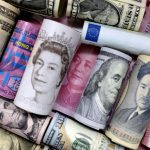
LONDON (Reuters) -The dollar held steady against the euro and the yen on Monday after the most volatile week of trading for the currency market in months, as investors assessed policy and geopolitical developments.
The market is laser-focused on the yen ahead of the Bank of Japan’s (BOJ) policy review on Friday.
The yen traded around 154.69 per dollar, a whisker away from last week’s 34-year low of 154.79 and close enough to the 155-level that is next on traders’ radars for possible intervention by Japanese authorities.
“There will be a focus on the BOJ meeting, but it is too soon for them to alter policy, and the market gives a change in rates no chance at all,” said Chris Weston, head of research at Pepperstone.
The dollar’s trade-weighted index was above 106, but off the five-month highs hit last week after comments from Federal Reserve officials and a run of hotter-than-expected inflation data forced a paring back of rate cut expectations.
A cooling in Middle East tensions, which had driven the dollar, gold and crude oil prices sharply higher on Friday and battered stock markets, also helped temper volatility. Tehran downplayed Israel’s retaliatory drone strike against Iran, in what appeared to be a move aimed at averting regional escalation.
Last week saw a big pickup in volatility. Deutsche Bank’s index of currency volatility rose 9.7% to its highest since February.
This was the biggest weekly rise in the index since September 2022, when the pound crashed to record lows against the dollar after the UK government’s spending plans threw British markets into crisis, and as the BOJ intervened to buy the yen for the first time since 1998.
Besides the BOJ meeting and one of the biggest weeks for U.S. earnings releases, investors will also get U.S. first-quarter gross domestic product data on Thursday and the inflation metric the Fed targets, the personal consumption price expenditures (PCE) index.
“FX has been centre-stage for the last few weeks and might take a backseat this week as earnings take centre-stage,” XTB research director Kathleen Brooks said.
“The FX market can only think at one thing at a time and right now, it’s obsessed with the strong dollar. So if we see any sign of any kind of weakening in the U.S. economy, that’s what we’re waiting for. But I don’t think we’re going to see it in the GDP report,” she said.
The strong dollar prevailed at last week’s International Monetary Fund/World Bank spring meetings in Washington too, and the United States, Japan and South Korea issued a rare joint statement on the issue.
Speaking after the Group of 20 (G20) finance leaders’ meeting in Washington, BOJ Governor Kazuo Ueda said the Japanese central bank may raise interest rates again if the yen’s declines significantly push up inflation, highlighting the dilemma the weak currency has become for policymakers.
The dollar has scorched higher against a range of currencies and yet the yen has been the worst performing major this year, with losses mounting to 9%.
The rethink on Fed easing has led to a general repricing of global rate cut timelines, but expectations for the European Central Bank (ECB) and the Bank of England (BoE) to start cutting by mid-year are still intact.
Analysts do not see too much room for U.S. Treasury yields to rise further, given the light economic data calendar for the rest of the month and how far they have already risen as investors reprice Fed expectations.
Two-year note yields have climbed 38 basis points this month to five-month highs above 5.0%.
China’s yuan slid to 7.2518 per dollar, its weakest since mid-November, despite the central bank’s daily benchmark guiding it higher and support from state-owned banks.
Bitcoin was last up 2.2% at $66,071. The world’s largest cryptocurrency completed its “halving” at the weekend, a phenomenon that happens roughly every four years and aims to reduce the rate at which bitcoins are created.
To read the full article, Click Here

